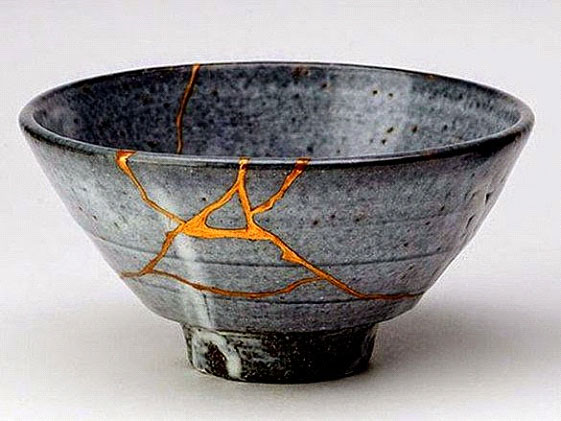Japanese Pottery

When something is broken, the first urge may often be to throw it away and quickly call Amazon and replace it with something new. Certainly, some machines and pieces need to be replaced and the game is called. This has implications for us beyond replacing a broken coffee mug as sometimes the world has taught us that broken pieces glued together holds less value.
At times, life is difficult for everyone. Trials and tribulations are guaranteed in life. Whether it is going through periods of anxiety, sadness, trauma, changes in relationships or jobs, we all have so many broken places inside ourselves. It can be hard to value our broken places. Even acknowledging where we feel broken can be tricky. Shame can come in so quickly and we can deny even to ourselves where we feel sad, worried or broken.
An Eastern perspective on this very human dilemma can give us different eyes on this issue. Japanese potters are some of the most skilled artisans in the world but even valued pieces can meet misfortune and break. In Japan, the century old art of repairing broken pottery is called “kintsugi” which means “beautiful joinery” or “beautiful repair.” The scars and cracks of these pieces become the focus of this newly transformed pot. When the pieces are joined together, typically a unique geometric design is formed. These broken pieces are not only joined with the rest of the ceramic but actually highlighted with gold or silver lacquer. In Japan, these ceramics are more valued than the original piece. No other pot can now be created that will be even close to this newly created pot. Each break is so intrinsically unique. How could another pot be created and then broken and rejoined in the same way. It would truly be impossible, which is why these newly reformed ceramics are so valued. Nothing like them can be created again.
In terms of human biology, we know that when a bone is broken but set well, the bone can become even stronger than before. In our lives, it can be easy to value our time before the pain, trauma, or whatever painful changes have occurred. It can be a true challenge to value the pain that we have survived.
“The world breaks everyone and afterwards, many are strong in the broken places.” -Ernest Hemingway
As we work to integrate the many aspects of ourselves and our lives, it is not possible to go through life without feeling broken. Valuing our own “beautiful repair” is an opportunity to value our broken places and move forward with our healing.
It is valuable information when we lose our temper or feel our emotional responses are an oversized reaction to whatever the events were. Sometimes shame comes up and in feeling shame, we can try to justify our responses. If we fall into the trap of explaining away responses and justifying behaviors, we can miss the valuable opportunity to learn. If we can try first to be really curious about our responses and value this new information, we can learn from it. The hurts and angers protect vulnerable parts of ourselves and we learned our responses to help us get through difficult circumstances.
Psychotherapy can be “beautiful repair” and “beautiful joinery” that help us to acknowledge and thank those protective parts, own our pain and broken pieces to be rejoined, allowing us to emerge stronger, more resilient and more knowledgeable about ourselves.


